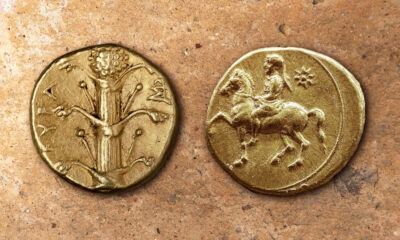Bizarre Nature
Fungi That Looks Like Human Body Parts
Fungi, mushrooms, and toadstools take on some truly weird shapes and many of them actually look like human body parts. These are the top ten strange looking fungi.

In the enchanting realm of nature’s artistic expression, a mesmerizing and peculiar phenomenon emerges – mushrooms and fungi that mirror the intricate forms of the human body. From the sinuous contours of the brain to the delicate curvature of the ear, the world of mycology unveils a gallery of astonishing resemblances that blur the boundaries between the organic and the surreal.
As if plucked from the palette of a master sculptor, these fungal resemblances offer a tantalizing glimpse into the hidden connections that bind humanity and the natural world, sparking wonder and igniting curiosity in equal measure. Step into this captivating exploration as we unveil the captivating saga of mushrooms that echo the very essence of our corporeal existence.
HEART / OLD MEAT
Latticed Stinkhorn / Clathrus Ruber

Clathrus Ruber: The Latticed Stinkhorn, Basket Stinkhorn, Heart of the Sorcerer
Human Body Part: The Heart / (SSPL-326662193)
This fungus often looks and smells like old torn meat during the latter stages of its development. Clathrus ruber is most often found in Europe but has spread to most other continents. It is not considered suitable for eating and is often mistaken for offal by humans and insects. As the lattice framework collapses it strongly resembles the remnants of a human heart. In France this unusual fungus is even referred to as the ‘Coeur de Sorcière’, which literally translated means ‘Heart of the Sorcerer’.
HUMAN EAR
Wood Ear Fungus / Auricularia auricula judae

Auricularia Auricula-Judae: Judas Ear, Wood Ear, Jews Ear, Chinese Fungus, Kikurage, Fungas Sambuca And Pig’s Ear Human Body Part: The Ear
Wood Ear fungi are often found growing on the bark of elder trees and are generally considered to be edible. It was originally known as the ‘Judas Ear’ fungus after Judas Iscariot who is said to have betrayed Jesus of Nazareth to the Romans for thirty pieces of silver. Judas had used his ears to listen to the seductive promises offered by the High Priest Caiaphas but after the crucifixion of Jesus he committed suicide by hanging himself from an elder tree which forever grows his ear as a reminder that people should be careful about what they listen to. Today, the fungus is used in both Chinese medicine and food. In Ghana it is used as a blood tonic and modern scientific research does indicate that it has anticoagulant and blood cholesterol-lowering properties.
BREAST & NIPPLE
Parasol Mushroom / Macrolepiota procera

Macrolepiota Procera: Snakes Hat, Snakes Sponge, Parasol Mushroom Human
Body Part: The Female Breast and Nipple
Blushing scientists claim to have never noticed the similarity between this mushroom and a woman’s breast and nipple regardless of the fact that these are roughly the same size. In fact, they decided that after the Phallus impudicus embarrassment they would name it after another object often associated with ladies – they called it the Parasol Mushroom. However, Macrolepiota procera literally translates as big scaled and tall. When fully grown, the cap is more or less flat, with a medium-brown papillate umbo (nipple) in the middle that is leathery to touch. The surrounding flakes or scales can be easily removed leaving a smooth pale skin. The parasol mushroom is slightly toxic when raw.
INTESTINES (Large)
False Morel / Gyromitra esculenta

Gyromitra Esculenta: False Morel, Turban Fungus, Headband Fungus, Intestine Toadstool
Human Body Part: The Large Intestine (SSPL-271348679)
Human intestines are not pleasant, and neither is the False Morel fungus. It is generally agreed to be highly toxic and if eaten raw will cause vomiting, diarrhoea, dizziness and head pain. If enough is ingested it will result in a coma followed by death with seven days. In Finland it is parboiled to make it safe to eat but research indicates that it may still contain toxins (monomethyl hydrazine) harmful to the kidneys and liver. It is sometimes confused with the (true) Morel mushroom which is edible and highly prized among culinary experts. Please note – even though the classification name – esculenta – means edible in English, this was a mistake. False Morel fungi should not be eaten.
INTESTINES (Small)
Jelly Drops Fungus / Ascocoryne sarcoides

Ascocoryne Sarcoides: Jelly Drops, Jellydisc, Fleshy Knotted Rod
Human Body Part: The Small Intestine / (SSPL-91751834)
Looking like an eviscerated small intestine this fungus generally takes the form of a pile of gelatinous pinkish-coloured tubes or discs. It’s often referred to as woodland jelly drops or jellydisc. Ironically, given that the human intestine is loaded with bacteria, laboratory studies have revealed that Ascocoryne sarcoides contains the antibiotic compound ascocorynin which is effective against aggressive stomach and intestinal flora known as Gram-positive bacteria including the common food spoilage organism Bacillus stearothermophilus. The term ‘sarcoides’ means flesh-like. It is generally considered to be inedible.
DEAD HAND
Devil’s Fingers Mushroom / Clathrus archeri

C. Archeri Var. Alba: Dead Hand, Zombie Hand, Devil’s Fingers
Human Body Part: The Hand
Generally known as devil’s fingers or octopus stinkhorn, this bizarre fungus can sometimes resemble a ghostly white hand that seems to be reaching out of the soil. Clathrus archeri starts as an egg-shaped pod that usually cracks open revealing what appears to be a pink embryo within a fine membrane. If the main pod develops enough then the ‘zombie-hand’ is said to appear as shown in the first picture (above). This variation is known as C. archeri var. alba and has only been recorded in India.

Octopus Fungus, Cage Archer Fungus
Human Body Part: The Hand / (SSPL-344854712)
In most cases the membrane breaks and reveals up to seven tentacles that are bright red and resemble a young octopus. It smells of decomposing flesh and a recent spate of sightings in the United Kingdom prompted a number of news channels to call it the alien egg fungus.
BLEEDING TOOTH
Bleeding Tooth Fungi / Hydnellum peckii

Hydnellum Peckii: Bleeding Tooth Fungus, Devil Tooth Fungus, Strawberry and Cream, Red-Juice Tooth
Human Body Part: A Tooth Specifically Molar / (By Holger Krisp – CC wikimedia.org)
During the early stages of its development Hydnellum peckii looks remarkably like a large molar that has been pulled out and is still splattered with blood from the extraction process. This has given it the common name – The Bleeding Tooth Fungus. It was originally from North America but has spread as far as Iran in the Middle East. Ironically, the blood-like fluid contains a pigment with anticoagulant properties comparable to the drug heparin. As it grows it loses its tooth like structure and eventually turns brown. This fungus is not known to be toxic but although it looks a little like a sweet or a dessert it is extremely bitter and classed as inedible.
KIDNEY
Lingzhi or Red Reishi Mushroom / Ganoderma lucidum

Ganoderma Lucidum: Red Reishi Mushroom, Lingzhi, Youngzhi, Shining Skin
Human Body Part: The Kidney / (SSPL-310204586)
Known as both the Lingzhi and Red Reishi mushroom, this fungus is highly prized for its medicinal properties. An important ingredient in Chinese medicines, it has been used for over 2000 years. It is often described as the spirit or soul mushroom and contains active compounds believed to stimulate the immune system thus promoting general well-being. It bears a striking resemblance to the human kidney and coincidentally is believed to have body cleansing properties.
MALE MEMBER
Stinkhorn: Shameless Phallus / Phallus impudicus

Stinkhorn: Shameless Phallus / Phallus impudicus
As far as shape goes, this fungus bears a striking resembles to an erect phallus. Impudicus actually translates as shameless. It is widespread across North America and Europe where it is known as the Common Stinkhorn. It certainly smells bad like a cross between rotting meat and sweaty gym shoes. There is a popular belief that gardeners of English country estates were often ordered to rise at dawn and destroy any of these mushrooms that had sprouted overnight in case they inadvertently aroused any passing gentlewomen. Apparently, these mushrooms can be eaten but due to their smell and texture are somewhat difficult to swallow. Common wisdom (which is often wrong) states that they have aphrodisiac qualities and are often fed in large quantities to young bulls to improve their performance. The tip of the mushroom often exudes a smelly slime said to be highly attractive to flies.
LIVER
Beef Steak Fungi / Fistulina hepatica

Human Liver
Its common English name is may be Beefsteak Fungus but when it’s full and well developed it also has a striking resemblance to the human liver. It can be eaten and is occasionally available in French markets where it is sometimes known as Foie de boeuf or ox liver. In fact, Fistulina hepatica literally translates as’ little tubes liver’. During food shortages it has been used as an alternative to meat but often requires lengthy cooking and must be harvested while still young. Just like meat it bleeds when cut and if prepared correctly, by simmering in hot water, does acquire a similar texture to liver. It is said to taste nothing like steak.
BRAIN
Brain Puffball / Calvatia craniiformis

Calvatia Craniiformis: Brain Mushroom, Skull Mushroom, Brain Fungus
Human Body Part: The Brain / (WMC Calvatia craniiformis 308991)
Often called the Brain Puffball or the Skull-shaped Puffball this fungus clearly resembles its name. So striking is the similarity that people who have seen a fully-grown specimen in its natural habitat have been fooled into thinking they have found human or animal remains. For centuries it has been used in traditional Japanese and Chinese medicine, usually as a dressing for wounds as it contains compounds that aid blood coagulation. It is said that while the flesh of the mushroom is white and firm it is edible and has a mild and pleasant flavour.
HEALTH WARNING:
Every year many hundreds of people are poisoned by eating fungus and mushrooms that they thought were edible and non-toxic. This article is not a guide to which mushrooms and fungus can or cannot be eaten. For safety reasons we advise against eating any of the fungus or mushrooms described in this list without first consulting an expert and ensuring your own safety.




















